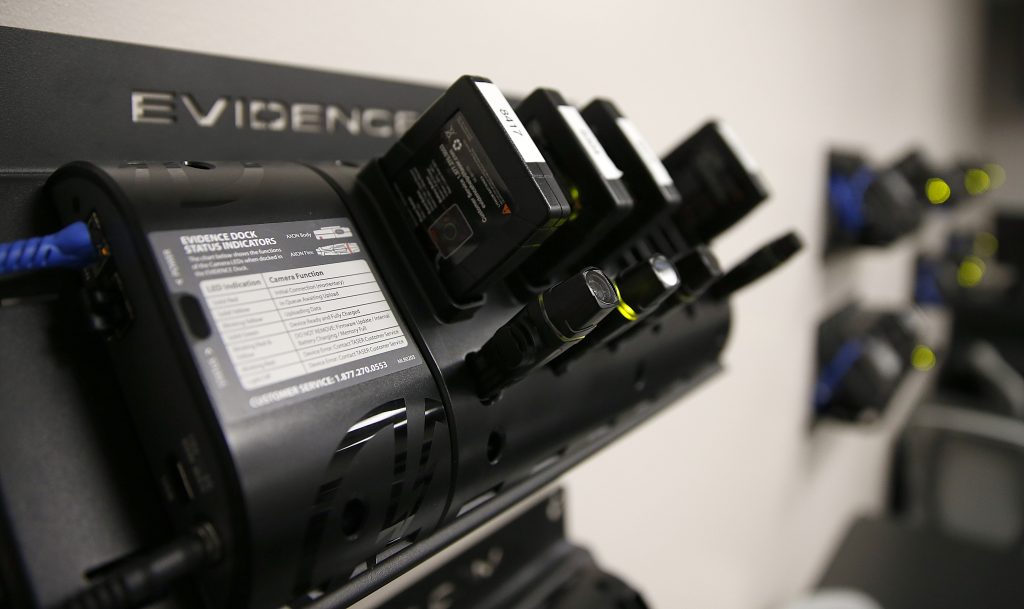The expansion of body-worn camera use among Maine law enforcement agencies has followed a nationwide trend in their increased use. (Photo by George Frey/ Getty Images)
The vast majority of Maine’s law enforcement agencies now use body-worn cameras amid a national expansion that criminal justice experts and communities have pushed for to increase accountability in policing. But despite that proliferation, Maine agencies have not kept pace with the latest evidence-based policies governing their use, making the cameras’ effectiveness unknown.
That’s according to a new report released earlier this week, which surveyed most of Maine’s law enforcement agencies and found a steadily increasing percentage of sheriff offices, campus safety offices and municipal police departments equipping officers with body cameras. This year, 70% of 107 agencies that responded to the survey said they used cameras, and another 21% said they were considering using them.
“Body-worn cameras are now becoming part of the uniform,” said George Shaler, senior research associate at the Catherine Cutler Institute at the University of Southern Maine, who coauthored the report commissioned by the Maine Attorney General’s office. “You will see even more agencies over the next couple of years adopt them as part of their toolkit.”
Research has shown that when high-profile events occur, there is an expectation that video footage exists and public pressure on law enforcement officials to release that footage, the report said. The presence of a body-worn camera is one of the most important tools in the evaluation of allegations of use of force in police-civilian encounters, according to public perception.
Maine’s agencies agree, with most sharing they support the use of body cameras to increase transparency and community relations, address civilian complaints and enhance officer safety.
However, while Maine’s police departments and sheriffs have invested thousands of state and federal dollars to equip officers with body cameras, many details about their use and effectiveness remain unclear. To what extent the cameras are being used, when they’re being turned on or off, how the footage is being stored and recorded and who can have access to it are still unknown due to the absence of a statewide policy or law governing body-worn camera use and transparency.
While 43% of respondents said their agency had not recorded a single instance of use of force, and 36% said there had been 10 or fewer incidents filed in the past 12 months, it is not clear whether these findings were revealed or otherwise impacted by the use of body cameras. Similarly, most Maine law enforcement agencies have had two or fewer complaints against officers in the past year, but what role body-worn cameras played in limiting this number is also unknown.
That leaves incomplete data statewide on the effectiveness of a tool the majority of law enforcement agencies are investing in, making it harder to determine whether the use of body cameras is actually resulting in more transparency, less police violence and fewer complaints about police officers.
“I think it’s great that on so many different levels that departments are moving in this direction,” Shaler said. “But that utility could be even greater if we had some uniformity when it comes to policies at the agency level.”
A steady increase in body camera use
Maine has followed the nationwide increase in body camera use. The number of agencies using body-worn cameras across the state more than doubled since 2017, when only 40% of agencies used them. Three years ago, that number was still less than half, with a quarter of all respondents to a 2021 survey saying they were considering them.
That increase has been despite a failed legislative attempt in 2019 to require their use. But now that body cameras have almost become part of the uniform for Maine sheriffs offices and police departments, some legislative guidelines would benefit the state in making sure their use is governed by best practices, Shaler said.
The expansion of body cameras has generally been received well by law enforcement leaders (most survey respondents were in leadership at their agency). Seventy percent said officers’ mental and physical health was improved by using body-worn cameras, and 68% said interactions with the public were also improved. Almost every survey respondent agreed that they were a useful evidentiary tool.
Body-worn camera policy needs updates
Many departments that use cameras rely on the Maine Chiefs of Police Association model policy, which has not been updated since it was published in 2015. Despite having some valuable components, the report noted the policy may need some revisions to keep up with the latest evidence-based practices.
“When it comes to using evidence to update and revise policy, we’re lagging a little behind on that right now,” Shaler said.
Of the 75 agencies using cameras who responded to the 2024 survey, 99% reported having a policy in place, and 70% of those with a policy indicated that it was publicly available.
Currently, policies around releasing footage also varies by agency, and is reliant upon interpretation of public records laws, the report found.
Purchasing cameras and storing video footage is an expensive endeavor for police departments. Nearly two-thirds of respondents — 65% — reported associated costs of $10,000 or less annually, the report said. That cost was the most common limiting factor for agencies that do not yet use them, and is another reason why the report’s authors recommend a statewide policy committed to regular updates to make sure use of body cameras is optimized, Shaler said.
“This ongoing oversight should balance the interests of the public while also promoting best use of technology and highest performance of law enforcement agencies,” the report said.
SUPPORT NEWS YOU TRUST.

